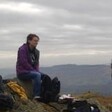Arts and Culture 19 December 2014

“Dabdoub Family, Bethlehem, 1900” by Nabil Anani.
An exhibition of paintings at Ramallah’s Zawyeh Gallery by the artist Nabil Anani has brought to life the busy, thriving society of pre-1948 Palestine.
Anani, one of Palestine’s most eminent living artists, is a ceramicist and sculptor as well as a painter, and has received a number of art prizes. Now retired, but still active in the Palestinian art world, he was born in Latrun — a village west of Jerusalem — and was five at the time of the Nakba, the 1948 dispossession of the Palestinian people. He graduated in 1969 from the University of Alexandria in Egypt, and his work has been exhibited throughout Europe, North America and East Asia.
In this latest exhibition, Life Before 1948, Anani’s paintings engage with the legacy of the Nakba, taking old photographs — family portraits or artistic images — and recreating them as deceptively simple, slightly other-worldly pictures of a lost life. Many of the paintings are called after the original people in the photographs, where this information is known.
As eminent Jerusalem-based art scholar Tina Sherwell writes on Anani’s website, “Photographic portraiture was an important form of cultural identity for the Palestinian community, recording the formations of lifestyles, family life, educational, economic and political institutions… The family album holds a unique place in the collective history and memory of Palestinians, in the absence of national archives, the multitude of personal albums and photographs embroiders the national narrative, and becomes a precious totem in recalling how life was.”

“Andolina Hawwa — Miss Palestine, Akka (1941)” by Nabil Anani.
Through the medium of these paintings, the exhibition engages with Palestinian society before it was devastated by the establishment of the State of Israel and the fragmentation of many families across different parts of the world. It shows the variety found at that time, depicting families both in traditional dress and Westernized clothing and settings, rural and urban.
But it also suggests a world that never had the chance to exist, the “what-might-have-been” of Palestinian society if the fracturing of 1948 hadn’t taken place. How would those people and families have grown up, gone on to live their lives? What society would they have built if Palestine had achieved independence and been allowed to develop like other countries?
The initial showing of this exhibition in Ramallah closes tomorrow (20 December). But friends of the artist have say that the exhibition will be repeated in Beirut and Paris during 2015. In the meantime, more of the images can be seen on Nabil Anani’s own website.





